|
|
|
Sort Order |
|
|
|
Items / Page
|
|
|
|
|
|
|
| Srl | Item |
| 1 |
ID:
088202
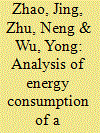

|
|
|
|
|
| Publication |
2009.
|
| Summary/Abstract |
According to statistics and field investigation, the energy consumption situation and reality of commercial building is described in this paper. As the first step of large-scale public building energy efficiency supervision system encouraged by central government of China, the energy consumption of several typical commercial buildings and public buildings was analyzed in detail. The main contents of investigation are as follows: basic information of building, operational record of energy consumption equipment, energy consumption of indoor equipments, energy-efficiency assessment of energy consumption systems and equipments, investigation of behavior energy saving, etc. On this basis further analysis and diagnosis including indoor thermal and humid environment, operation state of air-conditioning water system, operation state of air-conditioning duct system and operation management of air-conditioning system were implemented. The results show that the most energy consumption of buildings in this city is commercial buildings, which can reach to about 240 W/m2 per year. Further analysis tells that air conditioning systems play the major role of building energy consumption, and building energy saving has great potential in this city. In this paper, the ways of diagnosis work for building energy consumption are also described and discussed. Reasonable test, diagnosis and analysis are meaningful for building energy efficiency retrofit and management.
|
|
|
|
|
|
|
|
|
|
|
|
|
|
|
|
| 2 |
ID:
088208
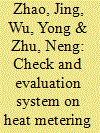

|
|
|
|
|
| Publication |
2009.
|
| Summary/Abstract |
Heat metering and energy efficiency retrofit of existing residential buildings in northern heating areas of China is organized and implemented in a large scale by local government in 15 provinces of North China with the unified guidance and control of central government. Firstly, this paper introduced the target of energy-saving reformation of existing residential buildings in North China and the importance of check and evaluation on this target, then pointed out the necessity of building up an evaluation system for energy-saving retrofit. According to the analytical hierarchy process (AHP), three-grade evaluation system was built up for heat metering and energy efficiency retrofit of existing residential buildings in northern heating areas of China. Also, based on multi-index comprehensive evaluation method combined with life cycle assessment (LCA) theory, post-evaluation thought and successful degree evaluation method, a mathematical model was established. Finally, a set of scientific method for evaluating heat metering and energy efficiency retrofit of existing residential buildings in northern heating areas of China systematically, scientifically, comprehensively and objectively was created.
|
|
|
|
|
|
|
|
|
|
|
|
|
|
|
|
| 3 |
ID:
088196


|
|
|
|
|
| Publication |
2009.
|
| Summary/Abstract |
As one of the biggest parts of total national energy consumption (TNEC), building energy consumption (BEC) catches public eyes and has been regarded as a crucial problem of the current society. For the past 20 years, BEC in china has been increasing at a high speed. To curb the rapid growing of BEC, china has enforced and implemented a series of policies. These include enforcing BEC constraints on new building projects, promoting more environment friendly building designs, establishing a more sophisticated legislation for building energy conservation, and increasing the total budget in the area of BEC control. This article analyzed china BEC situation and the challenges. As the main point, the measures required by China government to improve building energy efficiency were introduced as well
|
|
|
|
|
|
|
|
|
|
|
|
|
|
|
|
| 4 |
ID:
088222


|
|
|
|
|
| Publication |
2009.
|
| Summary/Abstract |
This article explores the threats that wind farms pose to birds and bats before briefly surveying the recent literature on avian mortality and summarizing some of the problems with it. Based on operating performance in the United States and Europe, this study offers an approximate calculation for the number of birds killed per kWh generated for wind electricity, fossil-fuel, and nuclear power systems. The study estimates that wind farms and nuclear power stations are responsible each for between 0.3 and 0.4 fatalities per gigawatt-hour (GWh) of electricity while fossil-fueled power stations are responsible for about 5.2 fatalities per GWh. While this paper should be respected as a preliminary assessment, the estimate means that wind farms killed approximately seven thousand birds in the United States in 2006 but nuclear plants killed about 327,000 and fossil-fueled power plants 14.5 million. The paper concludes that further study is needed, but also that fossil-fueled power stations appear to pose a much greater threat to avian wildlife than wind and nuclear power technologies.
|
|
|
|
|
|
|
|
|
|
|
|
|
|
|
|
| 5 |
ID:
088219
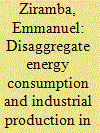

|
|
|
|
|
| Publication |
2009.
|
| Summary/Abstract |
This paper tries to assess the relationship between disaggregate energy consumption and industrial output in South Africa by undertaking a cointegration analysis using annual data from 1980 to 2005. We also investigate the causal relationships between the various disaggregate forms of energy consumption and industrial production. Our results imply that industrial production and employment are long-run forcing variables for electricity consumption. Applying the [Toda, H.Y., Yamamoto, T., 1995. Statistical inference in vector autoregressions with possibly integrated processes. Journal of Econometrics 66, 225-250] technique to Granger-causality, we find bi-directional causality between oil consumption and industrial production. For the other forms of energy consumption, there is evidence in support of the energy neutrality hypothesis. There is also evidence of causality between employment and electricity consumption as well as coal consumption causing employment.
|
|
|
|
|
|
|
|
|
|
|
|
|
|
|
|
| 6 |
ID:
088198
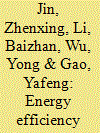

|
|
|
|
|
| Publication |
2009.
|
| Summary/Abstract |
This paper discusses energy consumption, building development and building energy consumption in China, and points that energy efficiency management and maintenance of large-scale public buildings is the breakthrough point of building energy saving in China. Three obstacles are lack of basic statistics data, lack of service market for building energy saving, and lack of effective management measures account for the necessity of energy efficiency supervision for large-scale public buildings. And then the paper introduces the supervision aims, the supervision system and the five basic systems' role in the supervision system, and analyzes the working mechanism of the five basic systems. The energy efficiency supervision system of large-scale public buildings takes energy consumption statistics as a data basis, Energy auditing as a technical support, energy consumption ration as a benchmark of energy saving and price increase beyond ration as a price lever, and energy efficiency public-noticing as an amplifier. The supervision system promotes energy efficiency operation and maintenance of large-scale public building, and drives a comprehensive building energy saving in China.
|
|
|
|
|
|
|
|
|
|
|
|
|
|
|
|
| 7 |
ID:
088197


|
|
|
|
|
| Publication |
2009.
|
| Summary/Abstract |
Buildings are important contributors to total energy consumption accounting for around 30% of all energy consumed in China. Of this, around two-fifths are consumed within urban homes, one-fifth within public buildings, and two-fifths within rural area. Government office buildings and large-scale public buildings are the dominant energy consumers in cities but their consumption can be largely cut back through improving efficiency. At present, energy management in the large public sector is a particular priority in China. Firstly, this paper discusses how the large public building is defined, and then energy performance in large public buildings is studied. The paper also describes barriers to improving energy efficiency of large public buildings in China and examines the energy-efficiency policies and programs adopted in United States and European Union. The energy-efficiency supervision (EES) systems developed to improve operation and maintenance practices and promote energy efficiency in large public sector are described. The benefits of the EES systems are finally summarized.
|
|
|
|
|
|
|
|
|
|
|
|
|
|
|
|
| 8 |
ID:
088217


|
|
|
|
|
| Publication |
2009.
|
| Summary/Abstract |
This study simulates a CO2 permit market in Romania using a dynamic general equilibrium model. The carbon constraint is set at 20.7% below the reference emissions level for sectors eligible according to the European Union Emission Trading Scheme (EU-ETS). Free permit distribution enhances growth despite a severe emissions cap, because environmental regulation stimulates structural changes [Porter, M., 1991. American's green strategy. Scientific American 264, 168]. That is, grandfathering allows sectors additional resources to invest in developing technologies, but it also raises the CO2 abatement costs because of energy rebound effects from enhanced growth. Results under endogenous growth [Romer, P.M., 1990. Endogenous technological change. Journal of Political Economy 98 (5), 71-102] are very similar to those obtained under an exogenous growth scenario [Ramsey, Y.F., 1928. A mathematical theory of saving. Economic Journal 38, 543-559], as the substitution effects are responsible for the majority of variations; in addition, Romanian research activities are too modest to significantly impact this system. The abatement cost per unit of GDP is higher under endogenous growth, as spillover effects reduce incentives to invest. Technological diffusion continues to have a positive impact on economic growth, which counterbalances the free-riding attitude adopted by some energy-intensive sectors, such as glass and cement.
|
|
|
|
|
|
|
|
|
|
|
|
|
|
|
|
| 9 |
ID:
088212
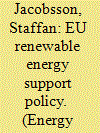

|
|
|
|
|
| Publication |
2009.
|
| Summary/Abstract |
The recent EU Commission proposal for promoting the supply of power from renewable energy sources was originally based on a pan-European, harmonised tradable green certificate (TGC) scheme. We suggest, on the basis of a multi-disciplinary analysis, that a pan-EU TGC system is not the way forward for Europe. It is vital that the Commission (and the majority of Member States) avoids implementation of such policy designs put forward by a coalition of vested interests. They should instead look at, and act upon, the available evidence from those countries that have experimented with TGCs (e.g. Flanders, UK and Sweden) and design policies that stand a better chance of meeting the criteria of effectiveness, efficiency and equity. In particular, the policies must enable EU to meet the immense innovation/industrialisation challenge by inducing the development of a capital goods industry that can, eventually, diffuse a broad range of technologies that use renewable energy sources. Only then we can acquire an ability to implement an industrial revolution in the energy system in a way that broadly meets the criteria of effectiveness and dynamic efficiency.
|
|
|
|
|
|
|
|
|
|
|
|
|
|
|
|
| 10 |
ID:
088221


|
|
|
|
|
| Publication |
2009.
|
| Summary/Abstract |
As an effective measure for environmental impact associated with the waste emissions, exergy is used to unify the assessment of the waste gases of CO, NOx, and SO2 emitted from fossil fuel consumption by the transportation system in China. An index of emission exergy intensity defined as the ratio of the total chemical exergy of the emissions and the total converted turnover of the transportation is proposed to quantify the environmental impact per unit of traffic service. Time series analyses are presented for the emission exergy and emission exergy intensity of the whole Chinese transportation as well as for its four sectors of highways, railways, waterways and civil aviation from 1978 to 2004. For the increasing emission exergy with CO taking the largest share, the highways sector was the major contributor, while the railways sector initially standing as the second main contributor developed into the least after 1995. The temporal and structural variations of the emissions are illustrated against the transition of the transportation system in a socio-economic perspective, with emphasis on policy-making implications
|
|
|
|
|
|
|
|
|
|
|
|
|
|
|
|
| 11 |
ID:
088206


|
|
|
|
|
| Publication |
2009.
|
| Summary/Abstract |
Energy efficiency retrofit for existing residential buildings (EERERB) in China's northern heating region is an important component of the national energy strategy. The main content and related subject in EERERB performance is the basis of understanding and developing targeted policies. So, this paper designed the content system of EERERB. And then, provided a cost-benefit analysis on related subjects, assessed the government's function in EERERB, and come to the conclusion that the Chinese government should increase fiscal fund investment and implement more fiscal and tax incentive policies. Moreover, in view of China's current policy, which lacks long-term mechanism and flexibility, this paper proposed specific policy recommendations, including clarifying the government's corresponding responsibilities at all levels and increasing the intensity of the central government's transfer payments. It further proposed targeted financial and tax policies for supporting and encouraging heating enterprises and owners, as well as policies to cultivate energy-saving service markets and to support the ESCO.
|
|
|
|
|
|
|
|
|
|
|
|
|
|
|
|
| 12 |
ID:
088224


|
|
|
|
|
| Publication |
2009.
|
| Summary/Abstract |
The most important contributors to the world's total oil production are the giant oil fields. Using a comprehensive database of giant oil field production, the average decline rates of the world's giant oil fields are estimated. Separating subclasses was necessary, since there are large differences between land and offshore fields, as well as between non-OPEC and OPEC fields. The evolution of decline rates over past decades includes the impact of new technologies and production techniques and clearly shows that the average decline rate for individual giant fields is increasing with time. These factors have significant implications for the future, since the most important world oil production base - giant fields - will decline more rapidly in the future, according to our findings. Our conclusion is that the world faces an increasing oil supply challenge, as the decline in existing production is not only high now but will be increasing in the future.
|
|
|
|
|
|
|
|
|
|
|
|
|
|
|
|
| 13 |
ID:
088214


|
|
|
|
|
| Publication |
2009.
|
| Summary/Abstract |
Closing the gap between carbon dioxide capture and storage (CCS) rhetoric and technical progress is critically important to global climate mitigation efforts. Developing strong international cooperation on CCS demonstration with global coordination, transparency, cost-sharing and communication as guiding principles would facilitate efficient and cost-effective collaborative global learning on CCS, would allow for improved understanding of the global capacity and applicability of CCS, and would strengthen global trust, awareness and public confidence in the technology
|
|
|
|
|
|
|
|
|
|
|
|
|
|
|
|
| 14 |
ID:
088201
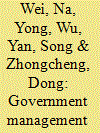

|
|
|
|
|
| Publication |
2009.
|
| Summary/Abstract |
The supervision of energy efficiency in government office buildings and large-scale public buildings (GOBLPB) is the main embodiment for government implementation of Public Administration in the fields of resource saving and environmental protection. It is significant for China government to achieve the target: reducing building energy consumption by 11 million ton standard coal before 2010. In the framework of a national demonstration project concerning the energy management system, Shenzhen Municipality has been selected for the implementation of the system. A data acquisition system and a methodology concerning the energy consumption of the GOBLPB have been developed. This paper summarizes the various features of the system incorporated into identifying the building consumes and energy saving potential. This paper also defines the methods to achieve the real-time monitoring and diagnosis: the meters installed at each building, the data transmitted through internet to a center server, the analysis and unification at the center server and the publication through web. Furthermore, this paper introduces the plans to implement the system and to extend countrywide. Finally, this paper presents some measurements to achieve a common benefit community in implementation of building energy efficiency supervisory system on GOBLPB in its construction, reconstruction or operation stages.
|
|
|
|
|
|
|
|
|
|
|
|
|
|
|
|
| 15 |
ID:
088199
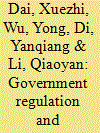

|
|
|
|
|
| Publication |
2008-09.
|
| Summary/Abstract |
The supervision of energy efficiency in government office buildings and large-scale public buildings is the main embodiment for government implementation of Public Administration in the fields of resource saving and environmental protection. Aimed at improving the current situation of lack of government administration in building energy efficiency, this paper proposes the concept of "change and redesign of governmental supervision in building energy efficiency", repositioning the role of government supervision. Based on this theory and other related theories in regulation economic and modern management, this paper analyzes and researches the action and function of all level governments in execution of the supervisory system of building energy efficiency in government office buildings and large-scale public buildings. This paper also defines the importance of government supervision in energy-efficiency system. Finally, this paper analyzes and researches the interaction mechanism between government and owners of different type buildings, government and energy-efficiency service institution with gambling as main features. This paper also presents some measurements to achieve a common benefit community in implementation of building energy-efficiency supervisory system.
|
|
|
|
|
|
|
|
|
|
|
|
|
|
|
|
| 16 |
ID:
088216


|
|
|
|
|
| Publication |
2009.
|
| Summary/Abstract |
This paper investigates the nexus between economic growth and oil price in small Pacific Island countries (PICs). Except Papua New Guinea, none of the 14 PICs has fossil any fuel resources. Consequently, the other 13 PICs are totally dependent on oil imports for their economic activities. Since PICs have limited foreign exchange earning capacities, as they have a very narrow range of exports and are highly dependent on foreign aid, high oil prices in recent months have seriously tested their economic resilience. This paper applies the ARDL bounds testing methodology to four selected PICs, Samoa, Solomon Islands, Tonga and Vanuatu, which have consistent and reliable time series of data, with a view to assess the impact of oil price on economic growth. The findings are that oil price, gross domestic product and international reserve are cointegrated in all the four PICs. Further, both in the long and short runs, we observe that there is a uni-directional relationship as causality linkage runs only from oil price and international reserves to economic growth. The paper makes some policy recommendations.
|
|
|
|
|
|
|
|
|
|
|
|
|
|
|
|
| 17 |
ID:
088220


|
|
|
|
|
| Publication |
2009.
|
| Summary/Abstract |
The paper presents further experiments with an extended version of a comprehensive model for assessment of energy technologies and research and development (R&D) planning to evaluate the impact of innovation programs on development of Iranian electricity-supply system. This analytical instrument is a model of energy R&D resource allocation with an explicit perspective of developing countries which has been linked to a bottom-up energy-systems model. Three emerging electricity generation technologies of solar PV, wind turbine and gas fuel cell are considered in the model and the impact of innovation programs on cost-reducing innovation for them is examined. The main results provided by the modeling approach include optimal allocation of R&D resources, induced capacity expansion policies to guarantee the effectiveness of R&D activities, competitive cost of emerging technologies, impact of innovation programs on optimal structure of electricity-supply system and benefits of innovation programs in the long-run.
|
|
|
|
|
|
|
|
|
|
|
|
|
|
|
|
| 18 |
ID:
088200
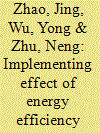

|
|
|
|
|
| Publication |
2008-09.
|
| Summary/Abstract |
The Chinese central government released a document to initiate a task of energy efficiency supervision system construction for government office buildings and large-scale public buildings in 2007, which marks the overall start of existing buildings energy efficiency management in China with the government office buildings and large-scale public buildings as a breakthrough. This paper focused on the implementing effect in the demonstration region all over China for less than one year, firstly introduced the target and path of energy efficiency supervision system, then described the achievements and problems during the implementing process in the first demonstration provinces and cities. A certain data from the energy efficiency public notice in some typical demonstration provinces and cities were analyzed statistically. It can be concluded that different functional buildings have different energy consumption and the average energy consumption of large-scale public buildings is too high in China compared with the common public buildings and residential buildings. The obstacles need to be overcome afterward were summarized and the prospects for the future work were also put forward in the end.
|
|
|
|
|
|
|
|
|
|
|
|
|
|
|
|
| 19 |
ID:
088207


|
|
|
|
|
| Publication |
2009.
|
| Summary/Abstract |
Starting with analyzing the investigation results by Ministry of Housing and Urban-Rural Development of China in 2005, more than half of the 10,236 participants are willing to improve the residential building energy efficiency and accept an additional cost of less than 10% of the total cost, the authors illustrate that incenting actions are necessary to improve building energy efficiency and build a central government-local government-market model. As a result of the model analysis, to pursue good execution effects brought by the incentive policies, the executors are required to distinguish the differences of incentive objects' economic activities and strongly respect the incenting on the energy conservation performance. A case study on the incentive policies of existing residential building energy efficiency improvement in heating zones in North China is given as well. Finally, it is strongly recommended to give the first priority to performance-based incentives so that to reduce the lazy behaviors of the incented objects and ensure the targets to be achieved.
|
|
|
|
|
|
|
|
|
|
|
|
|
|
|
|
| 20 |
ID:
088215
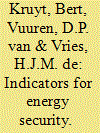

|
|
|
|
|
| Publication |
2009.
|
| Summary/Abstract |
The concept of energy security is widely used, yet there is no consensus on its precise interpretation. In this research, we have provided an overview of available indicators for long-term security of supply (SOS). We distinguished four dimensions of energy security that relate to the availability, accessibility, affordability and acceptability of energy and classified indicators for energy security according to this taxonomy. There is no one ideal indicator, as the notion of energy security is highly context dependent. Rather, applying multiple indicators leads to a broader understanding. Incorporating these indicators in model-based scenario analysis showed accelerated depletion of currently known fossil resources due to increasing global demand. Coupled with increasing spatial discrepancy between consumption and production, international trade in energy carriers is projected to have increased by 142% in 2050 compared to 2008. Oil production is projected to become increasingly concentrated in a few countries up to 2030, after which production from other regions diversifies the market. Under stringent climate policies, this diversification may not occur due to reduced demand for oil. Possible benefits of climate policy include increased fuel diversity and slower depletion of fossil resources.
|
|
|
|
|
|
|
|
|
|
|
|
|
|
|
|
|
|
|
|
|